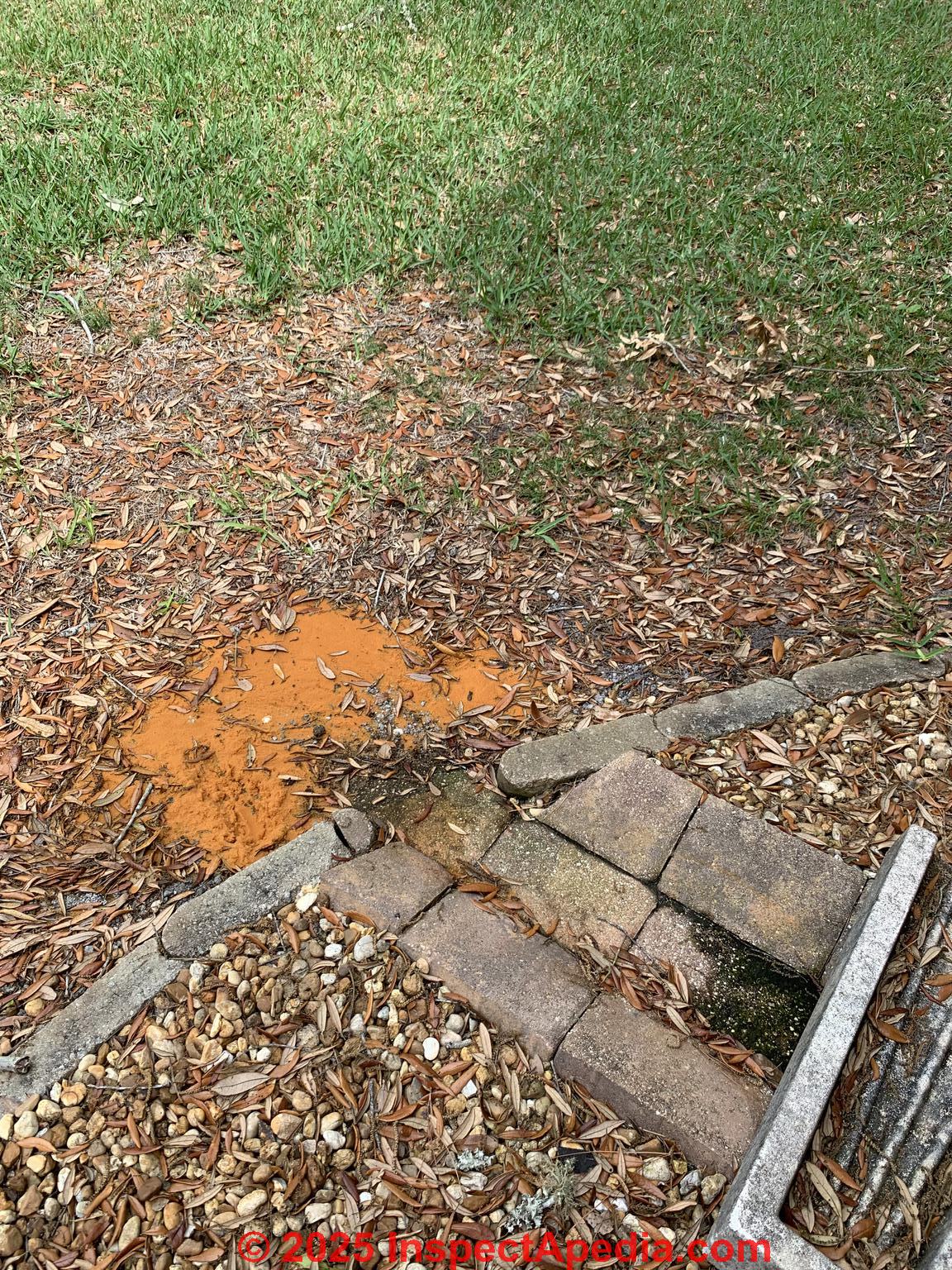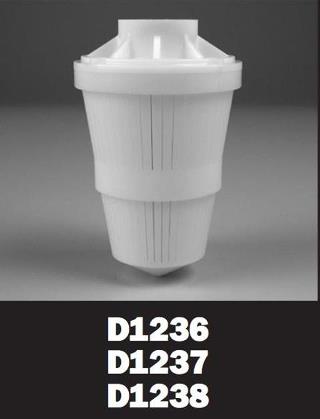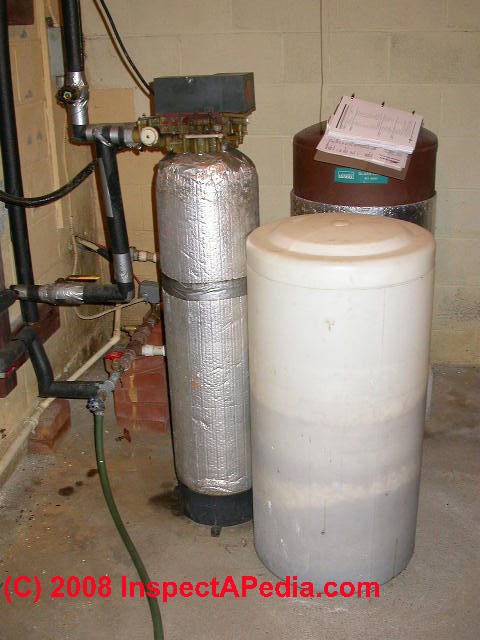 Water Softener Resin Loss Diagnosis & Cure
Water Softener Resin Loss Diagnosis & Cure
Water softener resin beads may show up at faucets; water softener resin bead sizes or mesh sizes
- POST a QUESTION or COMMENT about how to diagnose water softener operating problems: how long the softener runs, how much water is in the brine tank, how much salt, how salty or soft is the household water, more.
Diagnose & Fix Water Softener Resin Loss problems.
This article describes the symptoms of resin loss from a water softener and suggests how the problem may be repaired. If you see yellow or reddish debris at the water softener drain or at faucet strainers & shower heads, the water softener resin may be deteriorated or an internal part in the water softener may need replacement.
We include a description of the size range of water softener resin bead sizes or mesh sizes for regular and fine mesh softener resins and also we describe the stack distributor or filter mesh or opening sizes used.
Small find debris particles may indicate that the resin needs replacement, while larger particles may mean that a distribution basket or strainer is damaged or broken.
This article series describes procedures for diagnosing and repairing water softener or water conditioner problems including water conditioner control settings and adjustment or repair, brine tank and brine tank float cleaning and repair, and the proper amount of water softening or conditioning that is needed.
This water softener repair article describes what to check first if the softener is not working properly. Also see the FAQs at the end of this article for examples of water softener problems & solutions.
InspectAPedia tolerates no conflicts of interest. We have no relationship with advertisers, products, or services discussed at this website.
- Daniel Friedman, Publisher/Editor/Author - See WHO ARE WE?
Causes & Cure for Water Softener Resin Loss
Along with a description of algae contamination that can be mistaken for a resin problem, here we describe the most-common symptoms and causes of water softener resin loss.
Article Contents
- ALGAE GOO COMING OUT OF WATER SOFTENER FAQ - gooey red, green, brown contamination - this isn't resin, it's algae
- BASKET COLLAPSE CAUSE & CURE - what causes a broken or collapsed resin strainer basket
- COARSE BEADS COMING OUT OF WATER SOFTENER DRAIN - broken basket strainer
- COARSE BEADS & AIR DISCHARGE from WATER SOFTENER
- FINE DEBRIS COMING OUT OF WATER SOFTENER DRAIN - worn out softener resin
- WATER SOFTENER REPLACEMENT RESIN SOURCES
...
Algae Contamination of Water Softener
Cause & cure of gooey yellow-green substance coming out of my water softener
I have a 22 year old Fleck 2850 water softener. Lately the water flow has dropped.
I pulled the RFC20BB downstream filter and found it covered in a gooey yellow/gray/green substance which I assume is deteriorated resin.
Could this be caused by a leaking piston seal or a membrane failure? Or is it just a breakdown in the resin itself? Parts are hard to come by for this system and I would likely replace the system if it is the cause otherwise I could just change the resin. by Vince M
Reply by inspectapedia.com.moderator (mod) - algae contamination of water softener
@VinceM,
I suspect your softener is contaminated with algae; you probably need to clean and disinfect the system as well as replacing the resin.Follow the procedures found
at WATER SOFTENER CLEANING & SANITIZING
...
Causes of Softener Resin Bead Strainer Basket Collapse
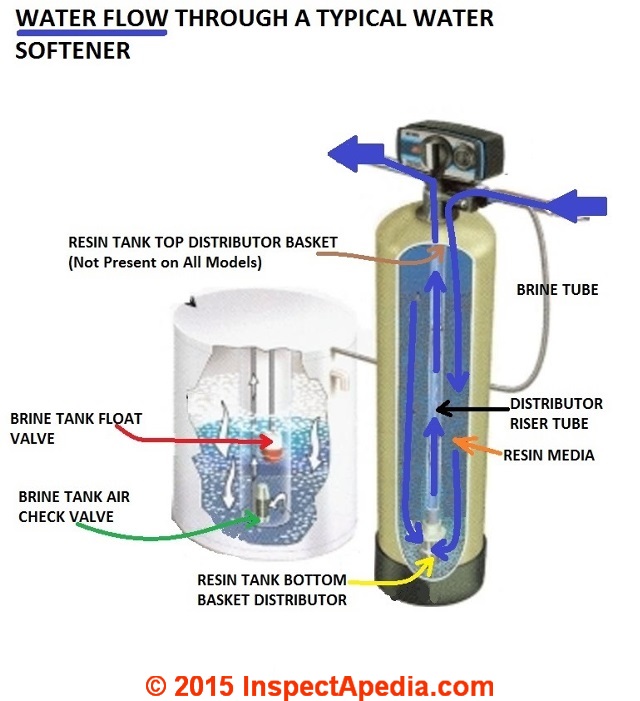 What caused
What caused
An InspectApedia reader asked:
I have a Fleck 5600 and recently found resin beads throughout my plumbing. I found the lower distributor basket is collapsed which let the beads enter the plumbing.
What would have caused the basket to collapse? I am on city water.
Could it have been excessive pressure from a pressure surge or was there a blockage that caused excessive pressure? I want to make sure I find the root of the problem so it does not happen again. - by Anonymous F
Reply by InspectApedia-911 (mod) - Possible causes of a collapsed resin bead strainer / distributor basket in a water softener
Possible causes of a collapsed resin bead strainer / distributor basket in a water softener:
[Note: not all buildings will have all of the parts and components listed here.]
1. water pressure surges:- is your building's water supply from municipal or private well?
- is there a water pressure regulator installed?
- is the water pressure regulator working & properly adjusted?
- does your water supply system have a water pressure gauge?
- what is the building water pressure level and over what does it range ? [Sometimes city water pressure can be quite high]
- are there or have there been other plumbing leaks in the building or plumbing failures that might be related to water pressure?
2. water hammer can cause pressure surges and damage water equipment.- Has your plumbing system ever been subject to water hammer?
- are there or have there been other plumbing leaks in the building or plumbing failures that might be related to water hammer?
3. municipal or private water that is corrosive or high in chlorine can accelerate the wear of plastic parts and can cause fagile plastic parts to become brittle.- what is your water's chemistry? Aggressive? Corrosive? Chlorine level?
4. Water softener age, condition, & installation details- How old is your water softener? What are the country & city of location?
- Was a suitable gravel bed included in the water softener resin tank during its installation?
Usually the gravel bed acts as a filter between the resin bed (that treats the water) and the outlet of the resin tank, serving to help keep resin in the tank.
- is there an activated charcoal filter (to reduce excessive chlorine levels in water) installed ahead of the softener resin tank?
5. Is there another possible source of water softener resin tank or distributor basket damage present in the system - such as an RO water treatment system left running when water to the building is turned off?- unusual sources of vacuum or negative pressure in the water system can damage some water softener tanks or components, particularly fiberglass resin tanks.
Note:
As you'll need to replace the distributor basket in your water softener, that's the time to replace the riser tube too, not just the basket, and to do all of that means replacing the resin beads and possibly the gravel bed as well.
Let us know what you find - answer our questions if you can, and keep us posted. Also I'd very much like to see a photo of that collapsed distributor basket.
...
Water Softener Resin Loss: strainer basket damage
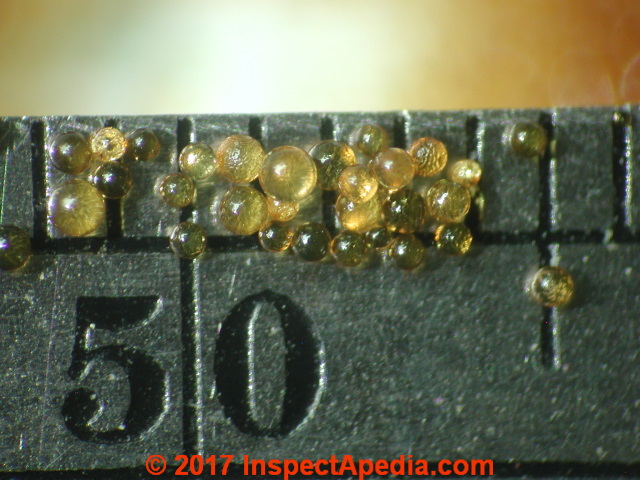 Softener blows coarse resin beads into the drain line during rinse or backwash cycle
Softener blows coarse resin beads into the drain line during rinse or backwash cycle
We have Pentair softener that blows resin directly to rinse/backwash drain line either during rinse or backwash cyle. Any ideas? - Anonymous
Reply by (mod)
@Anonymous,
Yes, usually that means that the strainer basket in the water softener is broken; its screen is intended to keep the resin beads in the softener while water can exit.
Usually the strainer basket is at the bottom of a dip tube in the softener but some models have the strainer at the top near the control head.
Identify the model of your Pentair and let's then take a look at its parts explosion diagram to find the part.
It's repairable, though a bit of work. Don't replace the softener, repair it.You or your plumber will need to replace the damaged or collapsed resin strainer basket on the water pickjup inside the water softener itself. Unfortunately it's quite a bit of work for a small repair since to replace the basket the softener treatment tank needs to be emptied of resin beads completely.
You'll use new resin when reassembling the system. Don't bother reusing the old resin.
In our OPINION given the time and labor to remove water softener resin and other parts to service the system, when re-assembling the softener it makes sense to install new water softener resin.
To change or replace a water softener strainer or basket at the top or bottom or both of the downtube in the treatment tank it's necessary to remove the softener control head, empty the softener of resin and gravel, pull out the dip tube and basket assembly and replace any damaged parts, and replace the gravel and resin.
Details of that procedure are at WATER SOFTENER RESIN REPLACEMENT
...
What is causing the resin loss & Air Discharge from my water softener?
Shown above: a top distribution basket for a typical water softener. Note that not all water softeners include this part. Many models use only a strainer baseket at the bottom of the water softener dip tube.
Source: www.aquapurification.com cited below.
Brine tank taking on air causing resin to discharge out of the drain during regen cycle.
I have a Fleck 5600 softener that appears to work through all cycles of regen and uses the appropriate amount of salt. The problem is after the water is sucked out of the brine tank it sounds like it is taking on air which is leading to resin coming out the drain during the following phase.
The air noise sounds like it is coming from the head unit, not the float valve in the tank. Any suggestions as to what could cause an air leak from the head unit? - Johnny
At above/left: water flow through a typical water softener, adapted from APSwater's water softener diagram cited below.
Reply:
Good question, Jonny and not one I've heard before. I'd look for a damaged O-ring in the control head and its valves.
Jonny said:
Thanks for the suggestion Dan. I checked all the internal O rings and they all appear to be in good shape.The air noise seems to be coming from near the piston or the bypass valve on the output side. If I close the bypass valve while it is making the air noise, the air sound stops.
The piston is in good shape and the spacers around it look decent as well, though not perfect. Is it possible there is an air leak by the bypass valve?
Moderator reply: RE: water softener media loss.
Are you sure that there is air in the system? If you see air discharge at faucets the answer is yes, else, perhaps no.
If yes, then see AIR DISCHARGE at FAUCETS, FIXTURES to diagnose and fix that problem as it may be originating outside of the softener itself (such as in well piping or water piping). It is possible that large amounts of air moving through a water conditioner might push media out of the unit.
Some of the water softener resin loss diagnosis sources I researched suggest that failing, clogging water conditioner resin can result in resin loss and suggest diagnosing that problem by looking in your faucet strainers or shower heads: if you see resin or sand-like particles there in the source could be softener resin.
Resin "fines" may show up as silt too: broken-up resin particles are moving out of the softener and through the water system.
Note that actual soil, clay, or sand may also show up in the water supply and in strainers and shower heads if it is coming from a private well, particularly for some water sources that contain silt or from a well with a cracked or damaged casing or from a well that is running low on water).
A second, different manifestation of water conditioner resin age-failure is reduced water flow through the system, something people may more loosely call reduced water pressure.
To diagnose this problem I have two suggestions.
1. Check for other causes of air discharge at faucets - see the link I gave earlier - AIR DISCHARGE AT FAUCETS (search InspectAPedia.com for that term).
2. Put the water conditioner / softener in BYPASS mode. If the silt and debris problem goes away (or the "air" problem goes away) then we're pretty sure the problem is indeed in the softener.
Air discharge traced to water softener - more things to check:
Some water softeners include an air disperser in the brine injector plumbing. Look at the parts explosion for your water softener for an air disperser that may be found in the valve body downstream from the injector assembly inside the control valve.
If this part is cracked, broken, or simply missing (following hasty repair work), air entering the system may cause weak brine flow as well as showing up as air discharge from the softener.
Air may be entering from the brine tank itself or from a leak in tubing connecting the brine tank to the water softener.
Jonny said:
Thanks again for your help Dan! After going through all of your suggestions and having a friend look at it, we are convinced there is no air leak after all. Something else is causing resin loss. This particular softener sat in bypass for a few years before I moved in. Could it simply be that the resin is now bad and it is more susceptible to coming out the drain?
There is no evidence of resin at any faucet and no air at any faucet. Water pressure does drop when the softener is running, but is not noticeable unless more than one faucet is running.
Reply:
Yes Jonny. In reviewing water softener resin problems to answer your question I learned that old failing resin can begin to break down: the resin grains can produce a fairly fine granular debris.
If a softener is losing resin the particles have to show up somewhere, that's why I suggested looking in shower heads and faucet strainers.
In your original question you suggested:
"The problem is after the water is sucked out of the brine tank it sounds like it is taking on air which is leading to resin coming out the drain during the following phase."
So if you don't see resin at any fixtures and you don't see air discharge at any faucets, how do we know there is resin loss?
Jonny said:
Sorry if I sound confusing! I checked all the faucets and there is no resin in the strainers or anywhere downstream of the softener.I know there is resin loss because the softener's drain line goes to my laundry tub and after a regen about 2-3 tablespoons of resin appears. I'm a bit confused myself to be honest.
Reply: Diagnosing & fixing resin loss from the water softener
OK thanks for clarifying .
If you are seeing air discharge at the softener drain I suspect there is still an air leak problem in the softener's control head, valves, or regen and salt tank piping, OR indeed the resin is old and sending out fines.
OR there could be a problem with regen cycle water velocity or with the components inside the water softener designed to retain the resin during backwash. If you are seeing coarse resin particles I suspect a damaged internal part in the water softener itself - permitting discharge of resin particles.
Water softeners often have a top and a bottom distribution basket, found at the top and bottom of the distributor riser tube. That's the tube I was discussing below. If the distributor basket is broken (or left out by some idiot who worked on the unit before you did) resin may not be retained in the water softener.
To solve this you may need to check the softener distribution basket:
(most homeowners will need help from a water softener repair technician for these steps)
- Put the water softener in bypass mode.
See BYPASS VALVE on WATER SOFTENERS if you're not sure how to do that - Disconnect the water softener entirely from the plumbing system - just leaving the bypass and control head in place so that the building continues to have water service.
- Open and disassemble the water softener itself. That means taking the following steps:
- Remove the water softener control head by un-screwing it from the resin tank body.
Watch out: when replacing the softener control head by re-connecting it to the water softener body, Fleck warns [with minor edits for clarity]
DO NOT exceed 15 ft-lbs (foot pounds) of torque when installing the water softener control head to the resin tank body. Exceeding this torque limit may damage the threads and cause water softener failure (and leaks).
Spin the valve onto the tank making sure that the threads are not cross-threaded, then rotate the valve freely without using force until it comes to a stop. (This position is considered "zero").
Then rotate the valve clockwise from "zero" to between 1/4 turn and 1/2 turn. STOP THERE.
- Remove the water softener control head by un-screwing it from the resin tank body.
- Check the condition of the distribution basket on the bottom of the vertical tube that receives treated water and sends it up to the softener outlet.
This basket is a strainer that keeps resin particles in the softener while allowing treated water out. Some water softeners also use a second distribution basket at the top of the riser tube, while still other water softener brands and models may use a "stack" type riser tube that permits inflow of treated water into the riser tube at several points along its height.
Watch out: Check the parts explosion for your water softener brand and model to see these details as well as for resin replacement and resin tank diagnosis and repair procedures specific to your water softener.
Also see WATER SOFTENER RESIN REPLACEMENT
I'll have posted an illustration of a typical distribution basket in water softeners at the start of this discussion.
...
Fine Particle Discharge from Water Softener: Worn Out Resin
Why am I getting this red stuff coming out of my Fleck water softener when the brine rinse drains?
I recently replaced my Fleck 5600 and am getting resin discharge where the brine rinse drains. Not seeing it in the faucets though. On 2023-04-29 by JD
Reply by InspectApedia Editor (mod)
@JD,
I'm not sure how all that fine red powdery stuff got onto the ground outside your home and thus out of your water softener, unless your water softener's regen cycle is discharging its wastewater outside onto the ground rather than into a building drain.Water softener repair manuals tell us that if you see very small or fine particles in the water softener discharge then the resin beads are deteriorated and the resin needs a complete replacement.
Follow the procedures
at WATER SOFTENER RESIN REPLACEMENT
It's also possible that there's an installation error or a missing or damaged strainer-basket in the resin tank but the symptom of that problem is usually the presence of larger or complete resin beads in the water softener discharge or even in building plumbing fixtures when water is drawn.
Watch out: all that dead grass around your water softener discharge may also tell us that salt in the brine tank regen/rinse cycle is killing your lawn; you're not dumping water softener discharge in the best location. - Daniel
What causes yellow stuff to come out of my softener and clog my washing machine filter?
I have a Performa water softener. It keeps plugging up my washing machine screen with a yellow substance and makes the washer not fill. - James
Reply: possible resin loss from a water softener
James
If the yellow stuff is fine granular debris (worn out softener resin beads) or larger round resin beads such as in our photo (broken resin bead strainer basket) then you'll need to replace the softener resin itself and/or replace the strainer badsket.
It as if the water softener is sending debris from the brine tank OR actual resin from the softener out with the house water supply.
You could try emptying and sanitizing the brine tank (articles here describe how to do that).
But I suspect it's a resin problem - which means it's time to call your local water conditioner company to take a look at the equipment. I'll do some further checking and comment further as well.
...
Water Softener Resin Tank Distributors & Stack Distributors & Distribution Riser Pipes
Most water softener manufacturers provide their own resin tank distribution baskets as well as other parts. However there are also more generic water softener riser tube and distribution basket manufacturers who sell these components are repair/replacement parts as well as providing them as OEM parts, as we cite below.
- APS Water, "Water Softener Diagram", [web page], Website: www.apswater.com, Tel: 800-460-9011, retrieved 2016/03/26, original source: http://www.apswater.com/article.asp?id=189&title=Water+Softener+Diagram. APS Water also sells water softener resin beads for all water softener brands and models.
Two types of water softener resin are most often found: "regular water softener resin beads" and fine-mesh water softener resin designed for use in softener models that use a finer mesh screen.
Fine mesh water softener resin can remove higher levels of iron in the water supply than the regular mesh. As APS points out, it's possible to convert a water softener to use a fine-mesh softener resin media but you'll need to change the strainer baskets.
Shown above: a bottom distribution basket found in the resin tank in a a typical water softener. Source: www.aquapurification.com cited below.
- Aqua Purification Systems, Inc.
PO Box 20856
San Jose, CA 95160 USA, Tel: 408-225-7974, Email: sales@aquapurification.com, Websites: www.aquapurification.com - www. birmfilter.com, retrieved 2013/03/26, original source: www.aquapurification.com/pdfs/tank_distributors/residential_distributors.pdf - source of replacement distribution baskets
Excerpt:
Clack Corporation has available a wide variety of top and bottom distributors for residential water treatment applications (up to 13" diameter). These distributors fall into two major categories, the segmented stack distributors and the molded basket distributors.
The segmented stack distributors consist of individual ABS segments which are held together with 8-18 stainless steel screws. The segmented stack distributors have the ability to open up when backwashed, removing any possible fines that might accumulate on the distributor.
The standard slot size is .010-.013. Segmented stack distributors are highly recommended for filter applications.
The segmented stack distributors are also available with .007-.010 slot size for demineralization and finer mesh resin applications.
A .016-.020 slot size is available for high flow applications. The molded basket distributors are made out of high impact FDA approved ABS plastic.
The fixed slot size is .010-.013. The molded basket distributors are designed for general domestic water softener use for 6" to 10" diameter tanks without a gravel support bed, or 12" to 13" diameter tanks with a gravel support bed. All of these distributors are easily solvent welded to PVC, ABS, or HIPS riser pipe.
...
...
Continue reading at WATER SOFTENER RESIN REPLACEMENT, or select a topic from the closely-related articles below, or see the complete ARTICLE INDEX.
Or see WATER SOFTENER RESIN LOSS FAQs - questions & answers posted originally at this page
Or see these
Recommended Articles
- WATER CONDITIONER / SOFTENER MANUALS
- WATER SOFTENERS & CONDITIONERS - topic home
- WATER SOFTENER ADJUSTMENT & CONTROLS
- WATER SOFTENER CLEANING & SANITIZING
- WATER SOFTENER RESIN LOSS
- WATER SOFTENER RESIN PROPERTIES & SOURCES
- WATER SOFTENER RESIN REPLACEMENT
Suggested citation for this web page
WATER SOFTENER RESIN LOSS at InspectApedia.com - online encyclopedia of building & environmental inspection, testing, diagnosis, repair, & problem prevention advice.
Or see this
INDEX to RELATED ARTICLES: ARTICLE INDEX to WATER TREATMENT SYSTEMS
Or use the SEARCH BOX found below to Ask a Question or Search InspectApedia
Ask a Question or Search InspectApedia
Try the search box just below, or if you prefer, post a question or comment in the Comments box below and we will respond promptly.
Search the InspectApedia website
Note: appearance of your Comment below may be delayed: if your comment contains an image, photograph, web link, or text that looks to the software as if it might be a web link, your posting will appear after it has been approved by a moderator. Apologies for the delay.
Only one image can be added per comment but you can post as many comments, and therefore images, as you like.
You will not receive a notification when a response to your question has been posted.
Please bookmark this page to make it easy for you to check back for our response.
IF above you see "Comment Form is loading comments..." then COMMENT BOX - countable.ca / bawkbox.com IS NOT WORKING.
In any case you are welcome to send an email directly to us at InspectApedia.com at editor@inspectApedia.com
We'll reply to you directly. Please help us help you by noting, in your email, the URL of the InspectApedia page where you wanted to comment.
Citations & References
In addition to any citations in the article above, a full list is available on request.
- [1] North Dakota Standards for Water Softeners, North Dakota General Authority Law, Chapter 62-04-08, Water Softener Units http://www.legis.nd.gov/information/acdata/pdf/62-04-08.pdf. "The objective of this chapter is to provide a standard of quality, capacity, and performance for water softener units. Water softener performance is to be based upon referee tests procedures described in section 62-04-08-09."
- In addition to citations & references found in this article, see the research citations given at the end of the related articles found at our suggested
CONTINUE READING or RECOMMENDED ARTICLES.
- Carson, Dunlop & Associates Ltd., 120 Carlton Street Suite 407, Toronto ON M5A 4K2. Tel: (416) 964-9415 1-800-268-7070 Email: info@carsondunlop.com. Alan Carson is a past president of ASHI, the American Society of Home Inspectors.
Thanks to Alan Carson and Bob Dunlop, for permission for InspectAPedia to use text excerpts from The HOME REFERENCE BOOK - the Encyclopedia of Homes and to use illustrations from The ILLUSTRATED HOME .
Carson Dunlop Associates provides extensive home inspection education and report writing material. In gratitude we provide links to tsome Carson Dunlop Associates products and services.



